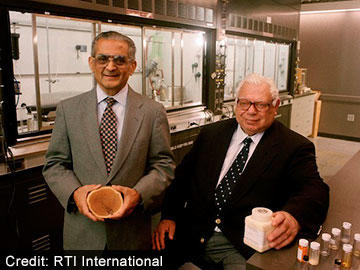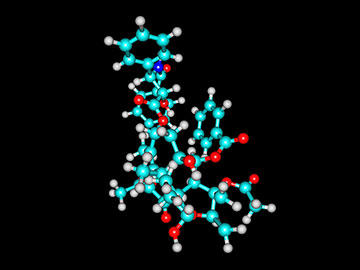A Story of Discovery: Natural Compound Helps Treat Breast and Ovarian Cancers
Key Points
- National Cancer Institute (NCI)-funded researchers unlocked the Pacific yew tree’s potential to treat cancer and developed the lifesaving compound paclitaxel (Taxol).
- Taxol, an antimitotic agent used to treat cancer, blocks cancer cell growth by stopping cell division, resulting in cell death.
- An NCI-funded clinical trial found that 30 percent of patients with advanced ovarian cancer responded positively to Taxol treatment.
- Today, Taxol is on the World Health Organization’s Model List of Essential Medicines as a cytotoxic drug that kills cancer cells. It is used to treat breast cancer, ovarian cancer, non-small cell lung cancer, pancreatic cancer, and AIDS-related Kaposi sarcoma.
Pathway to Discovery
In the second half of the 20th century, researchers realized the need for systemic treatments, such as chemotherapy and hormone therapy, to destroy cancer cells that had spread from the site of the original tumor to other parts of the body. They searched far and wide for the most effective products to cure cancer. In the 1960s, NCI-funded researchers discovered the lifesaving natural compound paclitaxel, which later became the cancer drug Taxol. Since its discovery, this remarkable compound has expanded treatment options for patients with breast and ovarian cancers, giving them hope for a cure. Taxol is also used to treat non-small cell lung cancer, pancreatic cancer, and AIDS-related Kaposi sarcoma. Today, it is recognized on the World Health Organization’s Model List of Essential Medicines, a list of the necessary and most important medications needed to support a basic health care system.
This extraordinary story of discovery begins in 1955, when NCI created the Cancer Chemotherapy National Service Center (CCNSC) in response to a call for increased cancer screening and treatment programs. At its inception, CCNSC mostly analyzed known and synthetic compounds. By 1960, NCI expanded the center through a partnership with the U.S. Department of Agriculture (USDA) to search for possible cancer cures from natural plant and animal products. Between 1960 and 1981, researchers collected and tested an incredible 30,000 samples under this program.
One of these samples proved to be pivotal to cancer therapy. In 1962, on an excursion in Washington State, USDA botanist Arthur Barclay collected bark and other samples from the Pacific yew tree. Two years later, Monroe E. Wall, Ph.D., and Mansukh Wani, Ph.D., who were under contract to NCI at the Research Triangle Institute in North Carolina, discovered that extracts from the Pacific yew were toxic to living cells. Dr. Wall and his colleagues then isolated the most cytotoxic compound from the bark of the tree and called it paclitaxel.
In 1977, after showing efficacy in mouse models, NCI confirmed paclitaxel’s antitumor activity and the drug was selected as a candidate for clinical development. In 1979, through a grant from NCI, Dr. Susan Band Horwitz at the Albert Einstein College of Medicine of Yeshiva University discovered how paclitaxel works. Dr. Horwitz found that the compound is an antimitotic agent that blocks cancer cell growth by stopping cell division, resulting in cell death. Even more exciting was that paclitaxel worked to prevent cell division through a different mechanism compared with other antimitotic drugs available at the time. This was an extraordinary discovery, as clinicians were struggling to treat patients who were developing drug resistance or not responding to available treatment options. Paclitaxel was proving to be a very promising discovery in cancer treatment.
The chemical structure of Taxol is unique and it looked extremely interesting to me…. Within a month, we knew that we had a very interesting molecule that was doing something to cells, which no one else had seen occur with a small molecule. It was very exciting.
Enhancing Cancer Care
In 1987, NCI-funded researcher Ross C. Donehower, M.D., and colleagues at the Johns Hopkins Oncology Center described paclitaxel as “a unique plant-derived substance that stops tumor growth.” These researchers also observed a dramatic and prolonged response to paclitaxel in a patient with cisplatin-resistant ovarian cancer during a phase I clinical trial. These initial results gave doctors hope that they might have a new tool to treat ovarian cancer that was not responding to traditional approaches.
Despite encouraging findings, subsequent clinical trials were delayed because of how slowly Pacific yew trees grow and the large amount of bark needed to produce therapeutic doses of the active ingredient, paclitaxel. There were also complexities involved in developing a synthetic version of the compound. Despite these challenges, in 1989—10 years after Dr. Horwitz’s research—the results were published from a phase II clinical trial led by NCI-funded researcher William P. McGuire, M.D., at the Johns Hopkins Oncology Center. Dr. McGuire and his colleagues found that an impressive 30 percent of patients with advanced ovarian cancer responded positively to paclitaxel treatment.
The slow growing nature of the Pacific yew and increasing demand for the compound led to another roadblock. Despite successful clinical trials, the drug was very expensive to manufacture and the ecological cost was too high—harvesting the bark kills the tree. To meet these challenges, researchers around the world raced to develop a synthetic form of the compound. In 1991, NCI partnered with the pharmaceutical company Bristol-Myers Squibb (BMS) for the commercial production of Taxol, using a semisynthetic form of the compound. A year later, the Food and Drug Administration approved Taxol for the treatment of ovarian cancer and in 1994 for the treatment of breast cancer. Today, Taxol remains one of the best plant-based cancer treatments available.
What’s Next for Taxol Research?
The future is bright for Taxol research. Currently, researchers are exploring ways to expand and improve the drug's use in cancer treatment. NCI is supporting several clinical trials to assess Taxol’s effect on ovarian, peritoneal, and fallopian tube cancers at different stages. Also, Dr. Horwitz and her team are continuing to conduct NCI-funded research on how tumor cells resist Taxol at the molecular level by studying Taxol’s interactions with other drugs to overcome drug resistance in tissue culture.
Researchers are also investigating the effect of Taxol on other types of tumors, such as head and neck, prostate, bladder, cervical, esophageal, thyroid and uterine cancers. Recent research is examining exactly how Taxol works to disrupt the normal function of microtubules, part of the cell’s key internal structure involved in mitosis. This work will help to develop better cancer drugs and improve Taxol and other drugs that kill cancer cells by inactivating the microtubules.
Taxol’s success has led other organizations and companies to join efforts to expand Taxol research. When combined with other cancer drugs, Taxol holds great promise to deliver more lifesaving treatment options. The Metastatic Pancreatic Adenocarcinoma Clinical Trial (MPACT) examined combination therapy in patients with metastatic pancreatic cancer. They found that patients treated with nab-paclitaxel (a form of paclitaxel) in combination with gemcitabine lived longer than patients treated with gemcitabine alone. Patients treated with both cancer drugs also lived longer without their disease getting worse (progression-free survival). In 2013, based on the results from MPACT, the FDA approved nab-paclitaxel for use in combination with gemcitabine to treat patients with metastatic pancreatic cancer.
Research to Practice: NCI’s Role
As a leader in cancer control and prevention, NCI championed research that led to the discovery and development of Taxol, a lifesaving cancer drug. NCI’s Developmental Therapeutics Program (DTP) supported the essential preclinical work and secured the difficult to get raw material needed to isolate the pure compound. Upon identification of Taxol, DTP developed a suitable formulation for human use, which was manufactured under NCI contracts, and supplied Taxol for the phase I and early phase II clinical trials. For more than four decades, NCI expanded Taxol research to provide improved treatment options for patients with breast and ovarian cancers. Thanks to NCI’s ongoing investment, Taxol offers better treatment outcomes, increased life expectancy, and improved quality of life for cancer patients. Today, NCI continues to support basic research that explores how Taxol works in different cell types and how it can be used to treat other types of cancer.
Key Takeaway
NCI researchers deliver a breakthrough discovery with Taxol, a naturally derived compound that expands treatment options for patients with breast and ovarian cancers.
Selected Resources
Albrethsen J, Angeletti RH, Horwitz SB, Yang CP. Proteomics of cancer cell lines resistant to microtubule-stabilizing agents. Mol Cancer Ther. 2014;13(1):260-269. [PubMed Abstract].
American Chemical Society. National Historic Chemical Landmarks. Discovery of Camptothecin and Taxol®. http://www.acs.org/content/acs/en/education/whatischemistry/landmarks/camptothecintaxol.html. Published 2003. Accessed November 24, 2014.
Chesnoff S. The use of Taxol as a trademark. Nature. 1995;373(6513):370. [PubMed Abstract]
Donehower RC, Rowinsky EK, Grochow LB, et al. Phase I trial of Taxol in patients with advanced cancer. Cancer Treat Rep. 1987;71(12):1171-1177. [PubMed Abstract]
Herman LC, Chen L, Garnett A, et al. Comparison of carboplatin-paclitaxel to docetaxel-cisplatin-5-flurouracil induction chemotherapy followed by concurrent chemoradiation for locally advanced head and neck cancer. Oral Oncol. 2014;50(1):52-58. [PubMed Abstract]
McGuire WP, Rowinsky EK, Rosenshein NB, et al. Taxol: a unique antineoplastic agent with significant activity in advanced ovarian epithelial neoplasms. Ann Intern Med. 1989;111(4):273-279. [PubMed Abstract]
Printz C. Scientist honored for work with paclitaxel: interest in a unique chemical structure leads to drug that helps millions. Cancer. 2011;117(3):2827-2828. [PubMed Abstract]
Sanders R. Discovery of how Taxol works could lead to better anticancer drugs. UC Berkeley News Center. 2014, May 22. http://newscenter.berkeley.edu/2014/05/22/discovery-of-how-taxol-works-could-lead-to-better-anticancer-drugs/
Schiff PB, Horwitz SB. Taxol stabilizes microtubules in mouse fibroblast cells. Proc Natl Acad Sci. 1980;77(3):1561-1565. [PubMed Central]
Von Hoff DD, Ervin T, Arena FP, et al. Increased survival in pancreatic cancer with nab-paclitaxel plus gemcitabine. N Engl J Med. 2013;369(18):1691-1703. [PubMed Central]
Weaver BA. How Taxol/paclitaxel kills cancer cells. Mol Bio Cell. 2014;25(18):2677-2681. [PubMed Central]
World Health Organization. WHO Model List of Essential Medicines. 18th edition. http://apps.who.int/iris/bitstream/10665/93142/1/EML_18_eng.pdf?ua=1. Published 2013. Accessed November 24, 2014.



